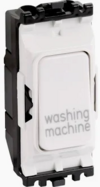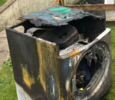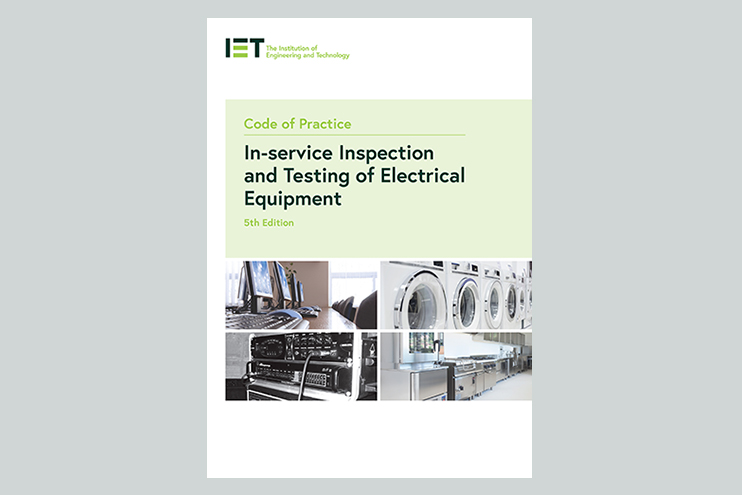- Joined
- 27 Jan 2008
- Messages
- 25,366
- Reaction score
- 2,982
- Location
- Llanfair Caereinion, Nr Welshpool
- Country

I washing machine (not washer/drier) and dishwasher have their heating elements running for a relatively short time, the drier however be it standalone or built into the washing machine where it uses resistive heating runs for quite a long time in comparison, so the appendix 15 of BS 7671 where it says
Also traditionally the washing machine would has a switch local to it, so it can be switched off without touching the washing machine. Grid switches like this often together with freezer etc, were common practice, in the main as washing machine weights have been known to come loose, and the machine could wreck a kitchen, where one can't get near it to turn it off, today washing machines tend to have a built in sensor so if the load is not even distributed it will auto switch off, so there is no longer the same NEED to fit one, however still common to fit them to supply any socket outlet hidden behind equipment so equipment can be isolated without pulling it out first.
often together with freezer etc, were common practice, in the main as washing machine weights have been known to come loose, and the machine could wreck a kitchen, where one can't get near it to turn it off, today washing machines tend to have a built in sensor so if the load is not even distributed it will auto switch off, so there is no longer the same NEED to fit one, however still common to fit them to supply any socket outlet hidden behind equipment so equipment can be isolated without pulling it out first.
So it is the drier which is the problem, be it built into the washer or stand alone, where it uses a resistive element, the heat pump drier, and the washing machines both for clothes and dishes are not really a problem as the heating element is used for such a short time.
On a 40ºC setting the washing machine in my sons narrow boat in spite of being rated at 2.3 kW would not trip a 6 amp B type MCB, it would trip a 4 amp, but not a 6 amp. It did not use the heating element for long enough.
As to water ingress this is unlikely, and would cause all sorts of other problems as well like a wet floor, and the RCD built into the modern consumer unit (Fuse Box) means should it happen it will likely fail safe.
So big question has to be, washing machine or washer/drier as this does change what is required. I note you can buy a duel inverter heat pump 9 kg washer drier, but at £750 they are not common as yet. However the heat pump drier is not cheap either, starting at around £400, as to if worth using a heat pump drier not so sure.
I had a resistive vented drier with a option of 1 or 2 kW and since the option was at back of machine, it was always set to 1 kW, it would run for 90 minutes, and some times the clothes were not dry, no built in sensor, so would be put on for a further ½ hour. The replacement heat pump drier uses around 600 watt, it does have a sensor, and runs for around 2½ hour for most loads, some do take longer.
So in real terms yes the heat pump does use less, but not that much less, it is hard to measure power use as it will start to turn the heat pump on/off with a mark/space ratio near the end of a long drying cycle, so I would estimate it uses around two thirds of the power used by the resistive type. But that is a lot less of a saving to what the reports say.
As to washer/drier, they clearly as built some 10 years ago wasteful in their use of water, as they used the cold water to cool the condenser, unlike the stand alone drier which used the ambient air in the room to cool the condenser heat exchanger, as to which is best not sure, as with a small room the room gets too hot, reducing efficiency.
However I digress, the point is power used, and so with a drier we have three common power use, 600 watt heat pump, and 1000 or 2000 watt with resistive, at 1000 watt no problem really, but although my drier had the option 1000 watt or 2000 watt, my washer/drier has no such option, you get what you get, and to be frank the washer/drier seems to get very hot, not sure it does the clothes much good. (I have a washing machine and heat pump tumble drier in centre floor, and washer drier in the lower floor so have both) I will happily leave the heat pump drier running unattended, but not the washer/drier too many pictures like this which I assume is a washer/drier as it looks like a concrete weight on the top, and stand alone driers don't have weights.
which I assume is a washer/drier as it looks like a concrete weight on the top, and stand alone driers don't have weights.
Likely the drier unless a heat pump type should be on its own dedicated circuit, however the stand alone washer and the dish washer although likely over the 18 kg where without wheels is considered fixed equipment not portable so following the advice to the letter should have a dedicated radial circuit, in the real world the load is for such a short time, it is unlikely to cause a problem.The load current in any part of the circuit should be unlikely to exceed for long periods the current-carrying capacity of the cable (Regulation 433.1.5 refers). This can generally be achieved by:
(i) locating socket-outlets to provide reasonable sharing of the load around the ring
(ii) not supplying immersion heaters, comprehensive electric space heating or loads of a similar profile from the ring circuit
(iii) connecting cookers, ovens and hobs with a rated power exceeding 2 kW on their own dedicated radial circuit
(iv) taking account of the total floor area being served. (Historically, limit of 100 m² has been adopted.)
Also traditionally the washing machine would has a switch local to it, so it can be switched off without touching the washing machine. Grid switches like this
 often together with freezer etc, were common practice, in the main as washing machine weights have been known to come loose, and the machine could wreck a kitchen, where one can't get near it to turn it off, today washing machines tend to have a built in sensor so if the load is not even distributed it will auto switch off, so there is no longer the same NEED to fit one, however still common to fit them to supply any socket outlet hidden behind equipment so equipment can be isolated without pulling it out first.
often together with freezer etc, were common practice, in the main as washing machine weights have been known to come loose, and the machine could wreck a kitchen, where one can't get near it to turn it off, today washing machines tend to have a built in sensor so if the load is not even distributed it will auto switch off, so there is no longer the same NEED to fit one, however still common to fit them to supply any socket outlet hidden behind equipment so equipment can be isolated without pulling it out first.So it is the drier which is the problem, be it built into the washer or stand alone, where it uses a resistive element, the heat pump drier, and the washing machines both for clothes and dishes are not really a problem as the heating element is used for such a short time.
On a 40ºC setting the washing machine in my sons narrow boat in spite of being rated at 2.3 kW would not trip a 6 amp B type MCB, it would trip a 4 amp, but not a 6 amp. It did not use the heating element for long enough.
As to water ingress this is unlikely, and would cause all sorts of other problems as well like a wet floor, and the RCD built into the modern consumer unit (Fuse Box) means should it happen it will likely fail safe.
So big question has to be, washing machine or washer/drier as this does change what is required. I note you can buy a duel inverter heat pump 9 kg washer drier, but at £750 they are not common as yet. However the heat pump drier is not cheap either, starting at around £400, as to if worth using a heat pump drier not so sure.
I had a resistive vented drier with a option of 1 or 2 kW and since the option was at back of machine, it was always set to 1 kW, it would run for 90 minutes, and some times the clothes were not dry, no built in sensor, so would be put on for a further ½ hour. The replacement heat pump drier uses around 600 watt, it does have a sensor, and runs for around 2½ hour for most loads, some do take longer.
So in real terms yes the heat pump does use less, but not that much less, it is hard to measure power use as it will start to turn the heat pump on/off with a mark/space ratio near the end of a long drying cycle, so I would estimate it uses around two thirds of the power used by the resistive type. But that is a lot less of a saving to what the reports say.
As to washer/drier, they clearly as built some 10 years ago wasteful in their use of water, as they used the cold water to cool the condenser, unlike the stand alone drier which used the ambient air in the room to cool the condenser heat exchanger, as to which is best not sure, as with a small room the room gets too hot, reducing efficiency.
However I digress, the point is power used, and so with a drier we have three common power use, 600 watt heat pump, and 1000 or 2000 watt with resistive, at 1000 watt no problem really, but although my drier had the option 1000 watt or 2000 watt, my washer/drier has no such option, you get what you get, and to be frank the washer/drier seems to get very hot, not sure it does the clothes much good. (I have a washing machine and heat pump tumble drier in centre floor, and washer drier in the lower floor so have both) I will happily leave the heat pump drier running unattended, but not the washer/drier too many pictures like this
 which I assume is a washer/drier as it looks like a concrete weight on the top, and stand alone driers don't have weights.
which I assume is a washer/drier as it looks like a concrete weight on the top, and stand alone driers don't have weights.
